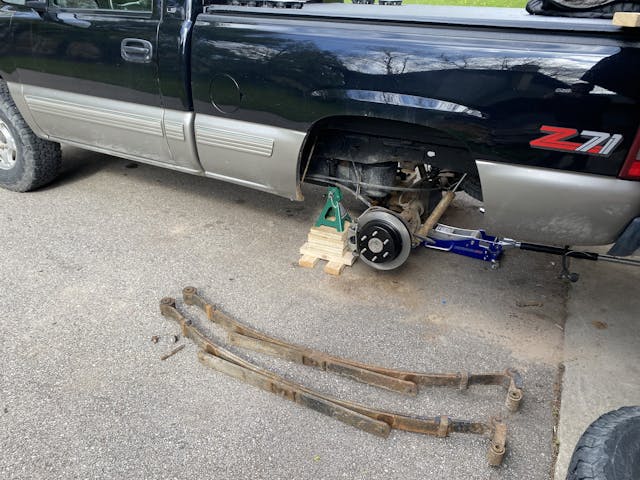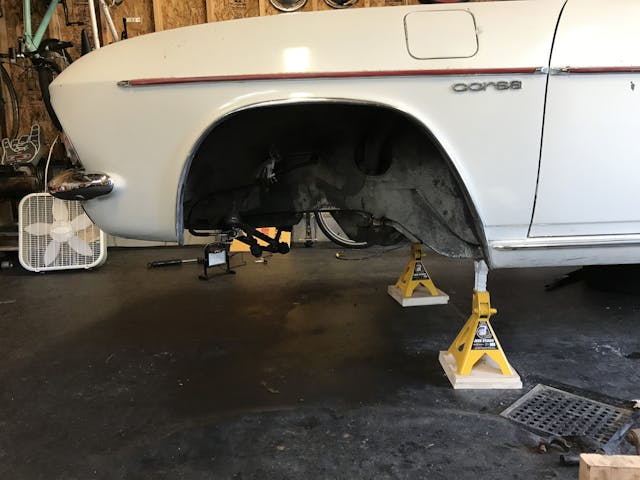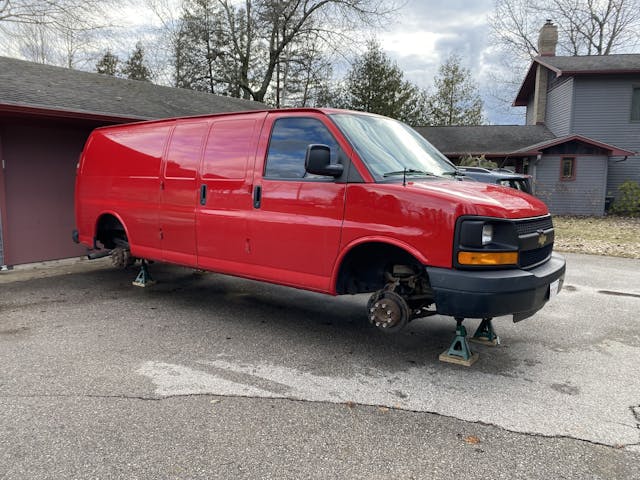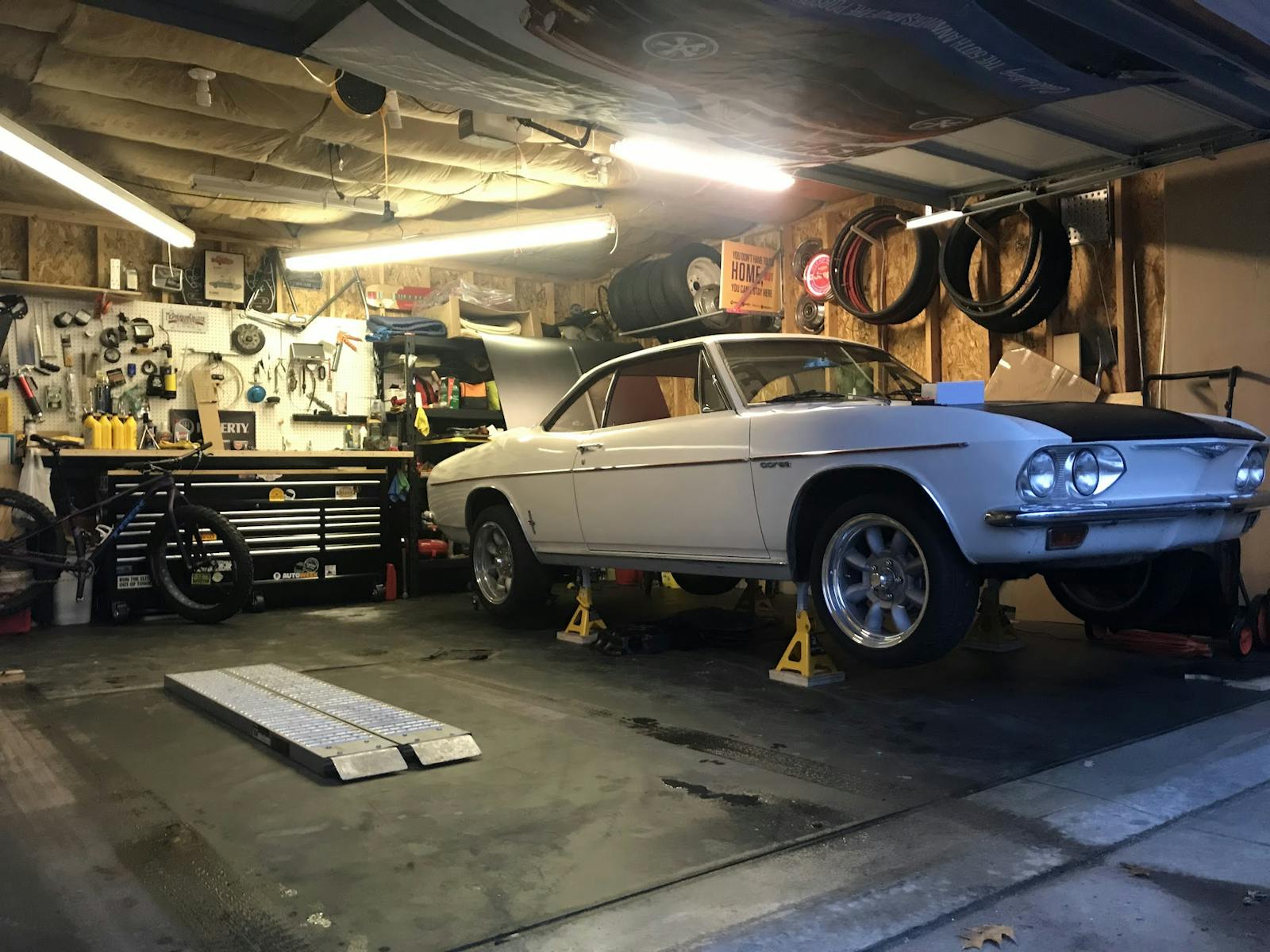Media | Articles
6 tips for using jack stands
Working on cars requires a whole slew of relatively specialized tools. Often times we don’t even realize how unique those tools and practices are until we talk to someone new to the hobby. Or someone who is on the outside looking in. Just one example: How casually we discuss (and practice) the act of lifting our multi-thousand pound vehicles into the air and then supporting them with separate load-bearing apparatuses that allow us to work on, disassemble, or reach under the vehicles. It’s dangerous when done right, and deadly when done wrong.
That sounds scary, and to a point it should be. Being cautious when the risks are this high is not a bad thing. That’s why we created a quick list of tips for using jack stands: good for newbies, but it’s also a refresher for those experienced enough to have lifted up a vehicle many times, in many ways over the years.
Buy once, cry never
There are many factors in selecting jack stands, and price is one that many of us are forced to consider. While tools can and will be shopped based on price point, jack stands should not be one of them. These are critical safety items that should come from reputable and trustworthy sources. The Harbor Freight jack stand debacle of 2020 should be burned in our collective memory for a long time, as being crushed by your car is not the way to go. Cheaping out with jack stands is a fast track to a mere feeling of safety, rather than possessing actual safety.
Jack stands should be sturdy with a good wide base. A secondary method of locking them at the desired height is also a plus. Do not modify jack stands or otherwise compromise safety features in the name of convenience. Doing so is only making it easier to get hurt.
Size appropriately
Jack stands produced after 2015 are rated as a pair. Which means if you find some at the local parts store that say they are “three-ton” jack stands, the ability to support the claimed 6000 pounds requires both stands. In reality, three-ton jack stands should be the smallest used in most home shops, as it gives a good safety margin when working on smaller cars, yet a set of four does have enough capability to hold a medium-sized truck or SUV in a pinch.
Marketplace
Buy and sell classics with confidence
Remember that storing jack stands can be a hassle, so having one set that covers anything you’ll work on is the best way to go. That said, a small and large set of them is a nice luxury if you have the space. Inevitably something gets “stranded” on your one set of stands…and you’ll need another set shortly thereafter.
Trace the load path
Jack stand placement is as critical (if not more critical!) than proper sizing. The biggest jack stand in the world is useless if you place it in the wrong spot, letting the car fall down anyway. The service manual is the best place to look for jack points and jack stand placements. Even the owner’s manual in the glove box, a book that’s been shrinking over time and loaded with “please see dealer” language, likely still outlines the jack points for safe lifting. A quick internet search will likely reveal appropriate information too.
But sometimes that doesn’t work, or what you are doing is something the original engineer from decades past could have never imagined. That’s when a little bit of critical thinking goes a long way. Look under the car and locate a place that looks sturdy enough to place a jack stand, then follow what that is connected to. From there, imagine how it would support the load being placed on it. Supporting the rear of a car by placing stands under the rear differential makes sense because the entire weight of the car is normally supported by that part. Using a bumper or frame brace that doesn’t support and wasn’t designed for that load is a bad place to put a stand. If unsure, consult professionals.
Do the shake test
Now that your project is up in the air and supported by jack stands, there is one last step before you roll underneath: You gotta shake it. No, not the latest TikTok dance. Shake the car. Go to one of the corners and give it a good push and pull to make sure the car is stable and the stands are not going to move or shift while you are underneath. This is the same thing that mechanics in shops do when putting a car on a two post lift.
After all, now is the time to find that the ground isn’t really flat or the stands aren’t fully seated on their safety catch. Only after a good shake can you roll under the car with confidence that it will not be coming down on top of you.
Buddy system
It feels strange to do when performing an innocuous task like adjusting a transmission shift cable or removing a driveshaft, but telling someone that you are working underneath a car with jack stands is a good practice. A text or call to a friend just to say “hey, I’m working on my project and am under the car for a bit” is enough of a heads up: if they don’t hear from you in awhile they know to check on your well being. Being pinned or injured under a car with no means to get help should be horrifying to you, and encourage you to whatever is necessary to prevent it.
Keeping a phone on your person is one option, as is using smart speakers or other items that require nothing more than yelling at them to activate them. I personally have a Google Home Mini above my workbench, which allows me to broadcast a message to another speaker inside my house by just yelling at it. This lets me feel safe-ish when I am working on projects while my wife is inside. (Presumably enjoying her time without me.) This practice isn’t for everyone, but it works for me. Find a system that works for you and use it.
Cribbing away that sinking feeling
Motorcyclists are familiar with the peril of asphalt: Ride somewhere on a warm day, set the bike on the kickstand, stop for a coffee, and the bike is laying on its side by the time you get back. Vandals? Inattentive drivers parking too-big SUVs? Nope. The asphalt did that.
Asphalt comes in a variety of flavors and mixtures, some of which isn’t nearly as solid as it feels under your feet. A heavy load concentrated on a small point can sink into asphalt. And the weight of that motorcycle leaning on the kickstand’s relatively small area can punch a hole into asphalt. Lo and behold, the kickstand sinks down enough that the motorcycle tilts and falls over. Bad news, but it points to a bigger problem.

Now picture this kickstand is actually a jack stand under your project. With no warning, the car can shift as the asphalt gives way. Prevent this by using something like a chunk of wood to spread the load of the jack stand to a larger area. The same applies for any soft substrate like gravel or dirt. Cribbing is a common thing in heavy equipment transport/service, and by extension is a smart exercise to do when working on light duty vehicles as well.
Have another safety tip to add to the list? We’d love to hear it, as you can’t be too safe in these situations. So leave a comment below for everyone’s safety and well being.
***
Check out the Hagerty Media homepage so you don’t miss a single story, or better yet, bookmark it. To get our best stories delivered right to your inbox, subscribe to our newsletters.













Opps! Randy beat me to it. I also leave the jack in place if I can work around it.
I have my cars supported by jack stands when working underneath them but also put my 6×6 wood blocking and spacers up to the frame for extra piece of mind as I am still not secure with just quality jack stands when working under them for any reason.
My procedure is to use at least two jack stands, in addition to my hydraulic floor jack. I just leave the floor jack in place as “insurance.” In addition, I put rubber chocks both in front of and behind one of the wheels that will stay on the concrete. As final insurance, as when doing brake work, I put the wheel with tire under the frame of the car. That may be overkill, but I am still alive and unhurt.
In regard to cinder blocks, I have experience in building with both cinder and concrete blocks, which are different animals. Cinder blocks have a compressive strength of 1500 psi, while concrete blocks are 5,000 psi. Cinder blocks are not designed to support heavy weights, while concrete blocks are used in load bearing walls, etc. Cinder blocks are simply fragile. It may be that some people refer to all blocks as “cinder blocks,” which is a misnomer. If you must use concrete blocks under your car, be absolutely sure that they are not cinder blocks and place them in the correct orientation. I would not use either one under a car since I own both large and small jack stands.
Vibration causes cinder blocks , concrete, bricks to fail. A vehicle on cinder blocks with someone using impact tools will cause vibration thus causing cinder block to fail. Hope this helps someone.
Mind blown. Never knew that about those materials. Thanks for learnin’ me!
Please stay away from cement blocks. We used them often when young until the following happened one day. My brother and I were doing front brakes and tie-rod ends while the car was on two cement blocks at the front. The wheels were off and my brother was sitting on the driveway with his legs under the front suspension while banging on something to get it apart. All of a sudden, all but one vertical side of the cement block on his side, crumbled and fell to the ground. ONLY one vertical side was there but miraculously still holding the car up! My brother immediately slid out from under the car without touching anything and I got the jack and jacked the front of the car up. As soon as the weight came off that remaining piece of cement block, like 1″x8″x16″, the top half of that piece toppled over, leaving the bottom piece standing there! That was a very lucky day for sure! It is still burned into my memory 45 years later. Spend the money and buy good jack stands and use them wisely.
Over the years I have used a combination of vehicle supports including wood blocking of all sizes, jack stands and ramps. I have to say I have foolishly used only a jack while working on wheels and tires. I have wised up and will NEVER do that again only because most short cuts are not worth the risk. I am even a little apprehensive using only jack stands. If I need to work under my 62 chevy for an extended time on fuel or brake lines, exhaust or any other maintenance not related suspension or wheels I have used ramps of 2×12 a little longer than the length of the car supported by 6 6×6 timbers on both sides and wooden ramps on the end to drive up on. Wheel chocks are secured at the the end so as not to drive off when I drive the car up on the ramp. I use a spotter while doing this. The wheels are then chocked all around. I can easily glide from one end to the other on my creeper and feel secure enough to even take a quick nap if needed. It is a bit of work but worth the peace of mind.
My FIL, a lifetime ASE Master Tech, would give me grief for using jack stands for simple stuff. Until he was under his truck checking something in the rear end and his 1979 long bed crew cab slipped off the jack nearly crushing his hand. He’s a believer now. I’m glad to hear it and that my idea to leave my jack in place as an extra safety was a good decision as well.
If a person is going to the trouble of cutting plywood into squares–why not cut them much larger, instead of large-to a bit smaller, to yet a bit smaller, etc. Make ALL of the pieces for the stack of plywood the same dimension. Furthermore–make them much larger than the footprint of the jack stand! This way, a mechanic does not have to lay a stack, trying to imagine a pyramid. A pyramid weakens the stack.
A typical set of 3 ton stands is usually about 12″ high at it’s lowest setting. Given that most cars are significantly lower to the ground compared to 20-30 years ago, at times I feel the car needs to be raised much higher (than I need to do the work) just to fit the stands in a secure location. While I haven’t done an extensive online search, does anyone know of a jack stand that the minimum setting height is around 6″ with a 3 ton rating? Great article as a reminder to proactively save your life from an unfortunate, careless accident.
Please use Wheel Chocks when using Ramps and/or Jack Stands
Even when on jack stands, I always make sure the floor jack is underneath as well.
I put my small sports car on wheel dollies for storage in my garage. I have found them ideal for working underneath the car as well as they lift the car sufficient enough for me to get under. Plus the wheels on the dollies lock so the car won’t be roaming around if I’m trying to loosen a stubborn bolt with a breaker bar.
Besides heavy jack stands properly placed and wheel chocks as necessary, I always leave a floor jack, just almost touching the bottom of the vehicle alongside where I’m working. If the worst happens, the jack has a pretty good chance of catching and holding the car on the side I’m on, and any damage to the underside of the vehicle is minor compared to the damage that would be done to me.
I’m always seeing my Man using flord jack & ramps , floor jacks ! I was impressed that he drove up just right , But what scares me is when he uses the floor jacks !!🙃 when I m there I put wood to make it doesn’t roll down fall on him ! So I check up on his as!! Thank you for the car info